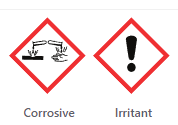| "Descrizione" by Frank123 (12058 pt) | 2023-Apr-13 16:31 |
Review Consensus: 10 Rating: 10 Number of users: 1
| Evaluation | N. Experts | Evaluation | N. Experts |
|---|---|---|---|
| 1 | 6 | ||
| 2 | 7 | ||
| 3 | 8 | ||
| 4 | 9 | ||
| 5 | 10 |
E363 (Succinic acid) is a chemical compound, short-chain dicarboxylic fatty acid and intermediate in the tricarboxylic acid cycle. It is produced industrially by hydrolysis and natural enzymatic fermentation with microorganisms (Basfia succiniproducens, Mannheimia succiniciproducens, Escherichia coli, Candida krusei, S. cerevisiae).
It appears as a fine white powder or colourless to white crystals. Soluble in ethanol, diethyl ether, acetone and methanol. Insoluble in toluene, benzene, carbon disulphide, carbon tetrachloride and petroleum ether.

What it is used for and where
Medical and Pharmaceuticals
Succinic acid is used in the pharmaceutical industry in a large number of fungicide and detergent products.
It is a main component of amber, which is commonly used for arrhythmia treatment. It has anti-inflammatory, antibacterial and cardioprotective properties.
Recently, succinic acid has been shown to be metabolically active in human health and could be considered as a potential therapeutic agent on renal cancer cell lines (1).
With a 2% succinic acid solution it is possible to reduce the level of Salmonella on broiler carcasses (2).
Topical application of succinic acid to acne lesions induced by Propionibacterium acnes has been shown to markedly suppress the induced inflammation and slow down its growth.
Segments of succinic acid improved the biodegradability and loading capacity of polyglycerol nanogels for dermal administration (3).
The nutraceutical, anti-ulcer and radiation-protective properties of succinic acid were also noted.
Used for the synthesis of tranquillisers, contraceptives and anti-cancer drugs.
Food
Succinic acid can be used as an acidic food agent to impart flavour to wines, baked goods, candies. Usually combined with soy sauce and monosodium glutamate (MSG).
Cosmetics
Surfactant, detergent additive and foaming agent.
Other uses
Agricultural industry as a herbicide. Also used in the chemical, leather and textile industries. Prevents metal dissolution and pitting corrosion in the galvanic industry. In the chemical industry for galvanic auxiliaries, dyes, leather, alkyd resins, glass-fibre reinforced plastics.
Detergent in semiconductors, printed circuit boards, electronic boards. Synthesiser of glass fibre reinforced plastics, PBS degradable plastics, analytical reagents.
For more information: Succinic acid studies
Typical commercial product characteristics Succinic acid
| Appearance | White powder or colorless to white crystals |
| Boiling Point | 236.1±13.0°C at 760 mmHg |
| Melting Point | 185°C |
| Flash Point | 110.9±16.3°C |
| Density | 1.4±0.1 g/cm3 |
| Chloride | ≤0.007% |
| Residues on Ignition | ≤0.025% |
| Sulphate | ≤0.01% |
| Iron | ≤20 ppm |
| Water Insolubles | ≤50 ppm |
| Water Solubility | 80 g/l (20 ºC) |
| pH | 2,7 (10g/l, H2O, 20°C) |
| PSA | 74.60000 |
| LogP | -0.59 |
| Vapor Pressure | 0.0±1.0 mmHg at 25°C |
| Index of Refraction | 1.478 |
| Safety |  |
 |  |
 |  |
- Molecular Formula C4H6O4
- Linear Formula HOOCCH2CH2COOH
- Molecular Weight 118.09
- Exact Mass 118.026611
- CAS 110-15-6
- UNII AB6MNQ6J6L
- EC Number 203-740-4
- DSSTox Substance ID DTXSID6023602
- IUPAC butanedioic acid
- InChI=1S/C4H6O4/c5-3(6)1-2-4(7)8/h1-2H2,(H,5,6)(H,7,8)
- InChl Key KDYFGRWQOYBRFD-UHFFFAOYSA-N
- SMILES C(CC(=O)O)C(=O)O
- MDL number MFCD00002789
- PubChem Substance ID 24899568
- ChEBI 15741
- RXCUI 37255
- NSC 106449 25949
- NACRES NA.25
- Beilstein 1754069
- RTECS WM4900000
- FEMA 4719
Synonyms
- Butanedioic acid
- Butane diacid
- Amber acid
- Asuccin
- Ammonium Succinate
- 1,2 Ethanedicarboxylic Acid
- 1,4 Butanedioic Acid
- Potassium Succinate
References_______________________________________________________________________
(1) Kasarci G, Ertugrul B, Iplik ES, Cakmakoglu B. The apoptotic efficacy of succinic acid on renal cancer cell lines. Med Oncol. 2021 Oct 23;38(12):144. doi: 10.1007/s12032-021-01577-9.
(2) Radkowski M, Zdrodowska B, Gomółka-Pawlicka M. Effect of Succinic Acid on Elimination of Salmonella in Chicken Meat. J Food Prot. 2018 Sep;81(9):1491-1495. doi: 10.4315/0362-028X.JFP-17-446.
(3) Zabihi F, Koeppe H, Achazi K, Hedtrich S, Haag R. One-Pot Synthesis of Poly(glycerol- co-succinic acid) Nanogels for Dermal Delivery. Biomacromolecules. 2019 May 13;20(5):1867-1875. doi: 10.1021/acs.biomac.8b01741.
| Evaluate |

